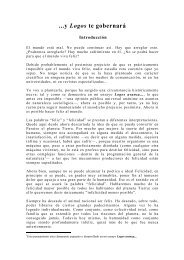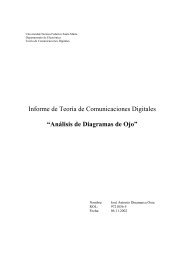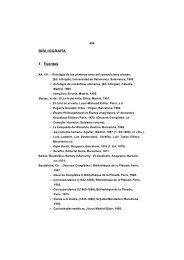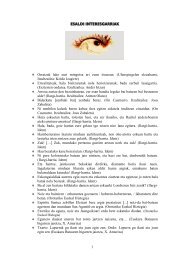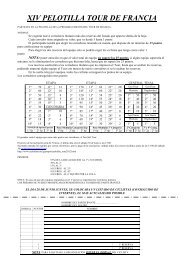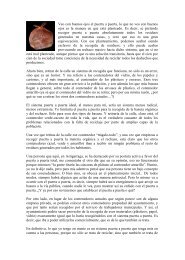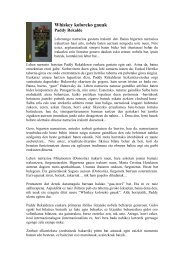Ejercicios de AN´ALISIS MATEM´ATICO
Ejercicios de AN´ALISIS MATEM´ATICO
Ejercicios de AN´ALISIS MATEM´ATICO
Create successful ePaper yourself
Turn your PDF publications into a flip-book with our unique Google optimized e-Paper software.
<strong>Ejercicios</strong> <strong>de</strong><br />
ANÁLISIS MATEMÁTICO<br />
Kepler Ck Ikastegia<br />
2001
Índice<br />
1 La topología <strong>de</strong> los espacios euclí<strong>de</strong>os 5<br />
2 Convergencia 23<br />
3
4 ÍNDICE
1<br />
La topología <strong>de</strong> los espacios<br />
euclí<strong>de</strong>os<br />
1. Sean a1, a2, . . . , an números reales no negativos. Demostrar<br />
que<br />
(a1 · · · an) 1<br />
n ≤ a1 + . . . + an<br />
n<br />
y que la igualdad se verifica si y sólo si a1 = · · · = an.<br />
(El miembro <strong>de</strong> la izquierda es la media geométrica y el miembro<br />
<strong>de</strong> la <strong>de</strong>recha es la media aritmética <strong>de</strong> los números a1, . . . , an).<br />
La propiedad se verifica si n = 2; en efecto,<br />
0 ≤ (a1 − a2) 2 = a 2 1 + a2 2 − 2a1a2 =⇒ 2a1a2 ≤ a 2 1 + a2 2 =⇒<br />
4a1a2 ≤ (a1 + a2) 2 ⇐⇒ (a1a2) 1<br />
2 ≤ a1 + a2<br />
.<br />
2<br />
También se cumple si n = 4; en efecto,<br />
(a1a2a3a4) 1 <br />
4 = (a1a2) 1<br />
2 (a3a4) 1 1<br />
2 (a1a2)<br />
2 ≤ 1<br />
2 + (a3a4) 1<br />
2<br />
2<br />
a1 + a2 + a3 + a4<br />
.<br />
4<br />
≤<br />
a1 + a2<br />
2<br />
Demostremos por inducción que la propiedad es cierta ∀ n = 2 k<br />
Supongamos que se cumple<br />
(a1 · · · a 2 k) 1<br />
2 k ≤ a1 + · · · + a 2 k<br />
2 k<br />
y veamos que entonces se cumple también para n = 2 k+1 .<br />
5<br />
+ a3 + a4<br />
2<br />
2<br />
=
6 1. LA TOPOLOGÍA DE LOS ESPACIOS EUCLÍDEOS<br />
(a1 · · · a 2 k · b1 · · · b 2 k)<br />
<br />
2 k+1<br />
1<br />
2k+1 =<br />
(a1 · · · a 2 k) 1<br />
2 k + (b1 · · · b 2 k) 1<br />
2 k<br />
2<br />
2 k+1<br />
<br />
a1 + · · · + a 2 k + b1 + · · · + b 2 k<br />
2 k+1<br />
<br />
(a1 · · · a 2 k) 1<br />
2 k · (b1 · · · b 2 k) 1<br />
2 k<br />
≤<br />
a1 + · · · + a 2 k<br />
2 k<br />
1<br />
2<br />
≤<br />
+ b1 + · · · + b 2 k<br />
2 k<br />
2<br />
Por tanto, la propiedad es cierta para todo número natural <strong>de</strong> la forma<br />
2k , k ∈ IN; veamos finalmente que también se cumple ∀ n ∈ IN arbitrario.<br />
Caso n = 3 Es claro que 2 < 3 < 22 a + b + c<br />
; sea d = entonces<br />
(abcd) 1 a + b + c + d<br />
4 ≤<br />
a + b + c<br />
3<br />
⇐⇒ (abc) 1<br />
3 ≤<br />
4<br />
⇐⇒ (abc) 1<br />
4<br />
a + b + c<br />
3<br />
⇐⇒<br />
<br />
abc<br />
a + b + c<br />
3<br />
1<br />
4<br />
<br />
a + b + c<br />
3<br />
a + b + c<br />
≤<br />
3<br />
3<br />
1<br />
4<br />
=<br />
⇐⇒ [(abc) 1<br />
3 ] 3<br />
4 ≤<br />
a + b + c<br />
3<br />
a + b + c +<br />
≤<br />
=<br />
4<br />
<br />
a + b + c<br />
Sea ahora n = k y supongamos que 2 m < k < 2 m+1 ; sea p ∈ IN |<br />
k + p = 2 m+1 y consi<strong>de</strong>remos b1 = · · · = bp = a1 + · · · + ak<br />
k<br />
Se sabe que la propiedad se cumple para 2m+1 luego<br />
⎛<br />
⎜<br />
⎝a1 · · · ak · b1 · · · bp<br />
<br />
2m+1 ⎞ 1<br />
k+p<br />
⎟<br />
⎠ ≤ a1<br />
a1 + · · · ak + + · · · + ak + pb1<br />
=<br />
k + p<br />
p(a1 + · · · + ak)<br />
k =<br />
k + p<br />
(k + p)(a1 + · · · + ak)<br />
=<br />
(k + p)k<br />
a1 + · · · + ak<br />
⇐⇒ (a1 · · · ak)<br />
k<br />
1<br />
a1 + · · · + ak<br />
k+p ≤ k<br />
p =<br />
a1 + · · · + ak k+p<br />
k<br />
k<br />
a1 + · · · + ak k+p <br />
⇐⇒ (a1 · · · ak)<br />
k<br />
1 k k<br />
k+p a1 + · · · + ak k+p<br />
k ≤<br />
⇐⇒<br />
k<br />
(a1 · · · ak) 1<br />
k ≤ a1 + · · · + ak<br />
k<br />
Por otra parte, a1 = · · · = an =⇒ (a1 · · · an) 1<br />
n = (an 1<br />
1 ) n = a1 = na1<br />
a1 + · · · + an<br />
; recíprocamente<br />
n<br />
3<br />
n =<br />
3<br />
4
=⇒ a1 = · · · = an; en efecto,<br />
n<br />
<strong>de</strong>mostraremos esta implicación viendo previamente que la propiedad es<br />
cierta cuando n = 2k ∀ k ∈ IN.<br />
Si n = 2 y (a1a2) 1<br />
2 = a1 + a2<br />
entonces 4a1a2 = (a1 + a2)<br />
2<br />
2 =⇒<br />
(a1 · · · an) 1<br />
n = a1 + · · · + an<br />
(a1 − a2) 2 = 0 ⇐⇒ a1 = a2.<br />
Supongamos que la propiedad es cierta para n = 2 k y veamos que entonces<br />
lo ha <strong>de</strong> ser también para n = 2 k+1 .<br />
Si (a1 · · · a 2 kb1 · · · b 2 k) 1<br />
2 k+1 = a1 + · · · + a 2 k + b1 + · · · + b 2 k<br />
(a1 · · · a 2 k) 1<br />
2 k + (b1 · · · b 2 k) 1<br />
2 k<br />
<br />
<br />
(a1 · · · a 2 k) 1<br />
2 k (b1 · · · b 2 k) 1<br />
2 k<br />
(a1 · · · a 2 k) 1<br />
2 k (b1 · · · b 2 k) 1<br />
2 k<br />
2<br />
1<br />
2<br />
1<br />
2<br />
≤<br />
2 k+1<br />
a1 + · · · + a 2 k<br />
2 k<br />
=⇒<br />
+ b1 + · · · + b 2 k<br />
2 k<br />
≤ (a1 · · · a 2 k) 1<br />
2 k + ( b1 · · · b 2 k) 1<br />
2 k<br />
= (a1 · · · a 2 k) 1<br />
2 k + (b1 · · · b 2 k) 1<br />
2 k<br />
2<br />
2<br />
2<br />
=<br />
=⇒<br />
don<strong>de</strong> se ha utilizado la <strong>de</strong>sigualdad probada en el apartado anterior.<br />
Ahora bien, la propiedad se cumple para n = 2 luego hemos <strong>de</strong> <strong>de</strong>ducir<br />
que<br />
(a1 · · · a2k) 1<br />
2k = (b1 · · · b2k) 1<br />
2k ⇐⇒ a1 · · · a2k = b1 · · · b2k y como esto es<br />
cierto para cualquier reorganización <strong>de</strong> los números a1, . . . , a2k, b1, . . . , b2k se <strong>de</strong>duce que necesariamente a1 = · · · = a2k = b1 = · · · = b2k Veamos finalmente que la propiedad es cierta para cualquier k ∈ IN; sea<br />
k ∈ IN y supongamos que 2m < k < 2m+1 . Entonces<br />
=⇒ a1 = · · · = ak , en efecto, si tomamos<br />
k<br />
b1 = · · · = bp = a1 + · · · + ak<br />
don<strong>de</strong> p ∈ IN es tal que k + p = 2<br />
k<br />
m+1 se<br />
tiene que<br />
(a1 · · · akb1 · · · bp) 1<br />
p 1 <br />
a1 + · · · + ak k+p<br />
k+p = a1 · · · ak<br />
= (a1 · · · ak)<br />
k<br />
1<br />
<br />
a1 + · · · + ak<br />
k<br />
k<br />
a1 p k<br />
k+p<br />
+ · · · + ak a1 + · · · + ak k<br />
=<br />
k<br />
k<br />
a1 + · · · + ak<br />
=<br />
k<br />
a1 + · · · + ak + b1 + · · · + bp<br />
k + p<br />
y como la propiedad es cierta para 2m+1 = k + p se <strong>de</strong>duce que<br />
(a1 · · · ak) 1<br />
k = a1 + · · · + ak<br />
a1 = · · · = ak = b1 = · · · = bp y en particular a1 = · · · = ak<br />
2. Sean a1, . . . , an y b1, . . . , bn dos conjuntos <strong>de</strong> números reales.<br />
Probar la i<strong>de</strong>ntidad <strong>de</strong> Lagrange:<br />
7<br />
p k<br />
k+p<br />
k<br />
=
8 1. LA TOPOLOGÍA DE LOS ESPACIOS EUCLÍDEOS<br />
2 <br />
n<br />
n<br />
ajbj = a<br />
j=1<br />
j=1<br />
2 <br />
n<br />
j b<br />
j=1<br />
2 <br />
j − 1<br />
n<br />
(ajbk − akbj)<br />
2<br />
j,k=1<br />
2<br />
Llamemos (1) al miembro <strong>de</strong> la izquierda y (2) al <strong>de</strong> la <strong>de</strong>recha. Se<br />
<strong>de</strong>mostrará por inducción sobre n:<br />
Si n = 2<br />
(1)=(a1b1 + a2b2) 2 = a2 1b21 + a22 b22 + 2a1b1a2b2 y<br />
(2)=(a2 1 +a22 )(b21 +b2 1<br />
2 )−<br />
2 [(a1b2 −a2b1) 2 +(a2b1 −a1b2) 2 ] = a 2 1b 2 1 +a 2 1b 2 2 +<br />
a 2 2b 2 1 + a 2 2b 2 2 − 1<br />
2 · 2(a1b2 − a2b1) 2 = a 2 1b 2 1 + a 2 2b 2 2 + 2a1b1a2b2<br />
luego es claro que (1)=(2).<br />
Supongamos ahora que la propiedad es cierta para n = k y veamos que<br />
entonces necesariamente lo es también para n = k + 1; en efecto,<br />
2 2 k+1 <br />
k<br />
(1)= ajbj = ajbj + a<br />
j=1<br />
j=1<br />
2 k+1b2 <br />
k<br />
k+1 + 2ak+1bk+1 ajbj =<br />
j=1<br />
<br />
k k<br />
− 1<br />
k<br />
(ajbi−biaj)<br />
2<br />
2 + a 2 k+1b 2 ⎛<br />
k<br />
⎝<br />
k+1+2ak+1bk+1<br />
a<br />
j=1<br />
2 j<br />
b<br />
j=1<br />
2 j<br />
Por otra parte<br />
<br />
k+1 k+1 <br />
(2)=<br />
i,j=1<br />
j=1<br />
⎞<br />
ajbj ⎠<br />
a<br />
j=1<br />
2 j b<br />
j=1<br />
2 <br />
j − 1<br />
k+1 <br />
(ajbi−aibj)<br />
2<br />
i,j=1<br />
2 ⎛<br />
k<br />
= ⎝ a<br />
j=1<br />
2 j + a 2 ⎞ ⎛<br />
k<br />
⎠ ⎝<br />
k+1 b<br />
j=1<br />
2 j<br />
k 1<br />
(ajbi −aibj)<br />
2<br />
i,j=1<br />
2 − 1<br />
k+1 <br />
(ak+1bi −aibk+1)<br />
2<br />
i=1<br />
2 − 1<br />
k+1 <br />
(aibk+1 −ak+1bi)<br />
2<br />
i=1<br />
2 =<br />
⎛<br />
k<br />
⎝ a<br />
j=1<br />
2 ⎞ ⎛<br />
k<br />
⎠ ⎝<br />
j b<br />
j=1<br />
2 ⎞<br />
⎠<br />
j + b 2 ⎛<br />
k<br />
⎝<br />
k+1 a<br />
j=1<br />
2 ⎞<br />
⎠<br />
j + a 2 ⎛<br />
k<br />
⎝<br />
k+1 b<br />
j=1<br />
2 ⎞<br />
⎠<br />
j + a 2 k+1b 2 k+1 −<br />
k 1<br />
(ajbi − aibj)<br />
2<br />
i,j=1<br />
2 − 2 · 1<br />
k+1 <br />
(ak+1bi − aibk+1)<br />
2<br />
i=1<br />
2 ⎛<br />
k<br />
= ⎝ a<br />
j=1<br />
2 ⎞ ⎛<br />
k<br />
⎠ ⎝<br />
j b<br />
j=1<br />
2 ⎞<br />
⎠<br />
j +<br />
b 2 ⎛<br />
k<br />
⎝<br />
k+1 a<br />
j=1<br />
2 ⎞<br />
⎠<br />
j + a 2 ⎛<br />
k<br />
⎝<br />
k+1 b<br />
j=1<br />
2 ⎞<br />
⎠<br />
j + a 2 k+1b 2 k+1 − 1<br />
k<br />
(ajbi − aibj)<br />
2<br />
i,j=1<br />
2 −<br />
<br />
k<br />
(a<br />
i=1<br />
2 k+1b 2 i + a 2 i b 2 k+1 − 2ak+1bk+1aibi) + a 2 k+1b 2 k+1 + a 2 k+1b 2 k+1 − 2a 2 k+1b 2 k+1<br />
⎛<br />
k<br />
⎝ a<br />
j=1<br />
2 ⎞ ⎛<br />
k<br />
⎠ ⎝<br />
j b<br />
j=1<br />
2 ⎞<br />
⎠+a j<br />
2 k+1b 2 k+1− 1<br />
k<br />
(ajbi−aibj)<br />
2<br />
i,j=1<br />
2 k<br />
+2ak+1bk+1 aibi<br />
i=1<br />
luego es claro que (1)=(2).<br />
+ b 2 k+1<br />
<br />
=<br />
⎞<br />
⎠−
3. Deducir la <strong>de</strong>sigualdad <strong>de</strong> Cauchy <strong>de</strong> la i<strong>de</strong>ntidad <strong>de</strong> Lagrange.<br />
<br />
n<br />
2 <br />
n<br />
≤<br />
<br />
n<br />
<br />
ajbj<br />
j=1<br />
a<br />
j=1<br />
2 j<br />
b<br />
j=1<br />
2 j<br />
y <strong>de</strong>mostrar que la igualdad se da si y sólo si las n-tuplas or<strong>de</strong>nadas<br />
(a1, . . . , an) y (b1, . . . , bn) son proporcionales.<br />
De la i<strong>de</strong>ntidad <strong>de</strong> Lagrange se <strong>de</strong>duce que<br />
<br />
n<br />
a<br />
j=1<br />
2 <br />
n<br />
j b<br />
j=1<br />
2 2 n<br />
j − ajbj =<br />
j=1<br />
1<br />
n<br />
(ajbk − akbj)<br />
2<br />
j,k=1<br />
2 ≥ 0 =⇒<br />
⎛ ⎞2<br />
⎛<br />
n<br />
n<br />
⎝ ajbj ⎠ ≤ ⎝ a<br />
j=1<br />
j=1<br />
2 ⎞ ⎛<br />
n<br />
⎠ ⎝<br />
j b<br />
j=1<br />
2 ⎞<br />
⎠<br />
j<br />
2 <br />
n<br />
n<br />
Por otra parte, si ajbj = a<br />
j=1<br />
j=1<br />
2 <br />
n<br />
j b<br />
j=1<br />
2 <br />
j ⇐⇒<br />
n 1<br />
(ajbk − akbj)<br />
2<br />
j,k=1<br />
2 n<br />
= 0 ⇐⇒ (ajbk − akbj)<br />
j,k=1<br />
2 = 0 ⇐⇒<br />
ajbk−akbj = 0 ∀ j, k ∈ {1, . . . , n} ⇐⇒ ajbk = akbj ∀ j, k ∈ {1, . . . , n} =⇒<br />
aj<br />
=<br />
bj<br />
ak<br />
∀ j, k ∈ {1, . . . , n} =⇒ (a1, . . . , an) y (b1, . . . , bn) son propor-<br />
bk<br />
cionales.<br />
Recíprocamente, si (a1, . . . , an) y (b1, . . . , bn) son proporcionales existe<br />
una constante K tal que (a1, . . . , an) = K(b1, . . . , bn); como<br />
a1 = Kb1, . . . , an = Kbn necesariamente es K2 = (a21 + · · · + a2n b2 1 + · · · + b2 n<br />
2<br />
n<br />
ajbj = (a1b1 + · · · + anbn)<br />
j=1<br />
2 = K2 (b2 1 + · · · + b2n) 2 =<br />
(a2 1 + · · · + a2n)(b2 1 + · · · + b2n) 2<br />
(b2 1 + · · · + b2 ⎛<br />
n<br />
= ⎝ a<br />
n)<br />
j=1<br />
2 ⎞ ⎛<br />
n<br />
⎠ ⎝<br />
j b<br />
j=1<br />
2 ⎞<br />
⎠<br />
j<br />
9<br />
luego<br />
4. Usando la <strong>de</strong>sigualdad <strong>de</strong> Cauchy establecer la <strong>de</strong>sigualdad<br />
triangular<br />
<br />
n<br />
(aj + bj)<br />
j=1<br />
2<br />
1 <br />
2 n<br />
≤ a<br />
j=1<br />
2 1 <br />
2 n<br />
j + b<br />
j=1<br />
2 1<br />
2<br />
j<br />
(Ésta última <strong>de</strong>sigualdad se conoce también como <strong>de</strong>sigualdad<br />
<strong>de</strong> Minkowski).
10 1. LA TOPOLOGÍA DE LOS ESPACIOS EUCLÍDEOS<br />
n<br />
(aj +bj)<br />
j=1<br />
2 <br />
n<br />
= a<br />
j=1<br />
2 <br />
n<br />
j + b<br />
j=1<br />
2 <br />
j +2 n<br />
<br />
n<br />
ajbj ≤ a<br />
j=1<br />
j=1<br />
2 <br />
n<br />
j + b<br />
j=1<br />
2 <br />
j +<br />
<br />
n<br />
2 a<br />
j=1<br />
2 1<br />
2<br />
j<br />
n<br />
b<br />
j=1<br />
2 1 ⎡<br />
2 n<br />
j = ⎣ a<br />
j=1<br />
2 1 <br />
2 n<br />
j + b<br />
j=1<br />
2 1 ⎤2<br />
2<br />
⎦<br />
j =⇒<br />
<br />
n<br />
(aj + bj)<br />
j=1<br />
2<br />
1<br />
2<br />
1<br />
n<br />
2<br />
≤ aj‘2<br />
j=1<br />
<br />
n<br />
+ b<br />
j=1<br />
2 1<br />
2<br />
j<br />
5. Sean a y b números reales no negativos y 0 < α < 1; <strong>de</strong>mostrar<br />
que<br />
a α b 1−α ≤ αa + (1 − α)b<br />
y que la igualdad se da si y sólo si a = b.<br />
Deducir <strong>de</strong> lo anterior que si r > 1 y s es su conjugado, es <strong>de</strong>cir,<br />
satisface la relación<br />
1 1<br />
+ = 1<br />
r s<br />
entonces cualesquiera que sean A y B positivos se tiene que<br />
AB ≤ Ar<br />
r<br />
+ Bs<br />
s<br />
siendo cierta la igualdad si y sólo si A r = B s<br />
Si a = 0 o b = 0 la <strong>de</strong>sigualdad es trivial; supongamos entonces que a > 0<br />
y b > 0; veamos que el polinomio p(x) = −xα + αx + 1 − α ≥ 0 ∀ x > 0<br />
y que a<strong>de</strong>más p(x) = 0 ⇐⇒ x = 1; en efecto,<br />
Si x > 1 el teorema <strong>de</strong>l valor medio garantiza la existencia <strong>de</strong> un<br />
p(x) − p(1)<br />
y ∈ (1, x) tal que = p<br />
x − 1<br />
′ (y) y como p(1) = 0 resulta<br />
p(x) = (x − 1)(α − αyα−1 <br />
) = α(x − 1) 1 − 1<br />
y1−α <br />
Ahora bien, 0 < α < 1 =⇒ 0 < 1 − α < 1 luego como y > 1 se tiene<br />
que y1−α > 1 =⇒ 1<br />
<br />
< 1 y así 1 −<br />
y1−α 1<br />
y1−α <br />
> 0 y en <strong>de</strong>finitiva<br />
p(x) > 0. Análogamente se <strong>de</strong>duce que si x < 1 entonces x − 1 < 0 y<br />
1 − 1<br />
z1−α <br />
< 0 y por tanto también en este supuesto p(x) > 0, siendo<br />
z ∈ (x, 1).<br />
Por otra parte, es claro que p(x) = 0 ⇐⇒ x = 1, así pues, como a<br />
> 0<br />
b
a<br />
necesariamente p ≥ 0 ⇐⇒ −<br />
<br />
b<br />
α <br />
a a<br />
≤ α + 1 − α ⇐⇒<br />
b b<br />
aαb1−α b<br />
a α b 1−α ≤ αa + (1 − α)b<br />
A<strong>de</strong>más se da la igualdad si y sólo si p<br />
Si ahora r > 1 y 1 1<br />
+<br />
r s<br />
y 1<br />
s<br />
α a<br />
+ α<br />
b<br />
≤<br />
11<br />
<br />
a<br />
+ 1 − α ≥ 0 ⇐⇒<br />
b<br />
αa + (1 − α)b<br />
⇐⇒<br />
b<br />
<br />
a<br />
= 0 ⇐⇒<br />
b<br />
a<br />
= 1 ⇐⇒ a = b<br />
b<br />
= 1 y A, B son positivos, entonces 0 < 1<br />
r<br />
< 1<br />
= 1 − 1<br />
r > 0 luego aplicando la propiedad anterior a a = Ar y a<br />
b = B s con α = 1<br />
r resulta<br />
(Ar ) 1<br />
r (Bs ) 1<br />
s ≤ Ar Bs<br />
Ar Bs<br />
+ ⇐⇒ AB ≤ +<br />
r s r s<br />
siendo cierta la igualdad si y sólo si Ar = Bs 6. Sean a1, . . . , an y b1, . . . , bn números reales positivos. Si<br />
r, s > 1 y 1 1<br />
+ = 1 establecer la <strong>de</strong>sigualdad <strong>de</strong> Höl<strong>de</strong>r:<br />
r s<br />
<br />
n<br />
n<br />
ajbj ≤ a<br />
j=1<br />
j=1<br />
r 1<br />
r<br />
j<br />
n<br />
b<br />
j=1<br />
s 1<br />
s<br />
j<br />
A partir <strong>de</strong> la <strong>de</strong>sigualdad <strong>de</strong> Höl<strong>de</strong>r, <strong>de</strong>mostrar la <strong>de</strong>sigualdad<br />
<strong>de</strong> Minkowski<br />
<br />
n<br />
(aj + bj)<br />
j=1<br />
r<br />
1<br />
r<br />
≤<br />
<br />
n<br />
a<br />
j=1<br />
r 1 <br />
r n<br />
j + b<br />
j=1<br />
r 1<br />
r<br />
j<br />
Observemos que si r = 2 entonces 1 1 1<br />
= 1− = luego la <strong>de</strong>sigualdad<br />
s r 2<br />
es cierta ya que se trata <strong>de</strong> la <strong>de</strong>sigualdad <strong>de</strong> Cauchy. En otro caso, sean<br />
1 1<br />
n r<br />
n s<br />
A =<br />
y B = ; aplicando el resultado 5.<br />
a aj<br />
A<br />
aj bj<br />
A B<br />
a<br />
j=1<br />
r j<br />
y bj<br />
B<br />
≤ 1<br />
r<br />
aj<br />
A<br />
1 1<br />
+ = 1 =⇒<br />
r s<br />
b<br />
j=1<br />
s j<br />
∀ j = 1, . . . , n resulta que<br />
r + 1<br />
s n<br />
bj<br />
=⇒<br />
s B<br />
n<br />
ajbj 1 a<br />
≤<br />
AB r<br />
j=1<br />
j=1<br />
r j<br />
Ar n 1 b<br />
+<br />
s<br />
j=1<br />
s j<br />
⎛<br />
n<br />
n<br />
n<br />
ajbj ≤ AB ⇐⇒ ajbj ≤ ⎝ a<br />
j=1<br />
j=1<br />
j=1<br />
r ⎞ 1<br />
r<br />
⎠<br />
j<br />
⎛<br />
n<br />
⎝ b<br />
j=1<br />
s ⎞ 1<br />
s<br />
⎠<br />
j<br />
=<br />
Bs
12 1. LA TOPOLOGÍA DE LOS ESPACIOS EUCLÍDEOS<br />
Por otra parte,<br />
n<br />
(aj + bj)<br />
j=1<br />
r = n<br />
(aj + bj)<br />
j=1<br />
r−1 (aj + bj) = n<br />
aj(aj + bj)<br />
j=1<br />
r−1 +<br />
n<br />
bj(aj + bj)<br />
j=1<br />
r−1 <br />
n<br />
≤ a<br />
j=1<br />
r 1<br />
r<br />
j<br />
n<br />
[(aj + bj)<br />
j=1<br />
r−1 ] s<br />
1<br />
s<br />
<br />
n<br />
+ b<br />
j=1<br />
r 1<br />
r<br />
j<br />
n<br />
[(aj + bj)<br />
j=1<br />
r−1 ] s<br />
1<br />
s<br />
⇐⇒<br />
n<br />
(aj + bj)<br />
j=1<br />
r <br />
n<br />
≤ [(aj + bj)<br />
j=1<br />
r−1 ] s<br />
1 ⎡<br />
s n<br />
⎣ a<br />
j=1<br />
r 1 <br />
r n<br />
j + b<br />
j=1<br />
r 1 ⎤<br />
r<br />
⎦<br />
j ⇐⇒<br />
<br />
n<br />
(aj + bj)<br />
j=1<br />
r<br />
<br />
<br />
n<br />
(aj + bj)<br />
j=1<br />
r<br />
⎛<br />
n<br />
1 ≤ ⎝ a<br />
s<br />
j=1<br />
r ⎞ 1 ⎛<br />
r n<br />
⎠<br />
j + ⎝ b<br />
j=1<br />
r ⎞ 1<br />
r<br />
⎠<br />
j ⇐⇒<br />
⎛<br />
n<br />
⎝ (aj + bj)<br />
j=1<br />
r<br />
⎞ 1 ⎛<br />
r n<br />
⎠ ≤ ⎝ a<br />
j=1<br />
r ⎞ 1 ⎛<br />
r n<br />
⎠<br />
j + ⎝ b<br />
j=1<br />
r ⎞ 1<br />
r<br />
⎠<br />
j<br />
habiéndose tenido en cuentaque 1 1<br />
+<br />
r s<br />
(r − 1)s = r y 1 − 1 1<br />
=<br />
s r<br />
7. Usando la <strong>de</strong>sigualdad <strong>de</strong> Höl<strong>de</strong>r, probar que<br />
1<br />
n<br />
⎛<br />
n<br />
aj ≤ ⎝<br />
j=1<br />
1<br />
n<br />
a<br />
n<br />
j=1<br />
r ⎞<br />
⎠<br />
j<br />
= 1 =⇒ r + s = rs y por tanto<br />
n n<br />
1<br />
1<br />
aj = aj<br />
n<br />
n<br />
j=1 j=1<br />
≤<br />
⎛<br />
n<br />
⎝ a<br />
j=1<br />
r ⎞ 1<br />
r<br />
⎠<br />
j<br />
⎛ ⎞ 1 ⎛<br />
n<br />
s s n<br />
1<br />
⎝ ⎠ = ⎝ a<br />
n<br />
j=1<br />
j=1<br />
r ⎞ 1<br />
r <br />
n<br />
⎠<br />
j<br />
ns 1<br />
s<br />
=<br />
⎛<br />
n<br />
⎝ a<br />
j=1<br />
r ⎞ 1<br />
⎛<br />
r 1 n<br />
⎠<br />
j n<br />
1−s s<br />
= ⎝ a<br />
j=1<br />
r ⎞ 1 ⎛<br />
r n<br />
1<br />
⎠ −<br />
j n r = ⎝ a<br />
j=1<br />
r ⎞ 1 ⎛<br />
r 1<br />
1 r<br />
⎠<br />
j = ⎝<br />
n<br />
1<br />
n<br />
a<br />
n<br />
j=1<br />
r ⎞<br />
⎠<br />
j<br />
8. Si a1 ≤ a2 y b1 ≤ b2 entonces (a1 − a2)(b1 − b2) ≥ 0 y por<br />
tanto,<br />
a1b1 + a2b2 ≥ a1b2 + a2b1<br />
Demostrar que si a1 ≤ · · · ≤ an y b1 ≤ · · · ≤ bn entonces<br />
1<br />
r<br />
1<br />
r
n n<br />
<br />
n n<br />
ajbj ≥ aj bj<br />
j=1<br />
j=1 j=1<br />
La propiedad es cierta si n = 2; en efecto, si a1 ≤ a2 y b1 ≤ b2 =⇒<br />
(a1 − a2)(b1 − b2) ≥ 0 ⇐⇒ a1b1 + a2b2 ≥ a1b2 + a2b1 ⇐⇒<br />
2(a1b1 + a2b2) ≥ a1b2 + a2b1 + a1b1 + a2b2 = (a1 + a2)(b1 + b2)<br />
Veamos ahora que la propiedad se cumple para k ∈ IN arbitrario; sean<br />
a1 ≤ · · · ≤ ak y b1 ≤ · · · ≤ bk entonces<br />
⎧<br />
⎪⎨<br />
a1 ≤ a2 y b1 ≤ b2 =⇒ (a1 + a2)(b1 + b2) ≤ 2(a1b1 + a2b2)<br />
k−1<br />
⎪⎩<br />
.<br />
.<br />
.<br />
a1 ≤ ak y b1 ≤ bk =⇒ (a1 + ak)(b1 + bk) ≤ 2(a1b1 + akbk)<br />
⎧<br />
⎪⎨<br />
a2 ≤ a3 y b2 ≤ b3 =⇒ (a2 + a3)(b2 + b3) ≤ 2(a2b2 + a3b3)<br />
k−2<br />
⎪⎩<br />
.<br />
.<br />
.<br />
a2 ≤ ak y b2 ≤ bk =⇒ (a2 + ak)(b2 + bk) ≤ 2(a2b2 + akbk)<br />
<br />
1<br />
.<br />
.<br />
ak−1 ≤ ak y bk−1 ≤ bk =⇒ (ak−1 + ak)(bk−1 + bk) ≤ 2(ak−1bk−1 + akbk)<br />
Por tanto, sumando miembro a miembro las <strong>de</strong>sigualda<strong>de</strong>s, se <strong>de</strong>duce<br />
que<br />
<br />
k<br />
k<br />
(k−1)a1b1+a1 bj +b1 aj +<br />
j=2<br />
j=2<br />
k<br />
<br />
k<br />
ajbj+(k−2)a2b2+a2 bj +<br />
j=2<br />
j=3<br />
<br />
k<br />
b2 aj +<br />
j=3<br />
k<br />
ajbj + · · · + ak−1bk−1 + ak−1bk + bk−1ak + akbk ≤<br />
j=3<br />
<br />
k<br />
2(k − 1) ajbj es <strong>de</strong>cir<br />
j=1<br />
<br />
k<br />
k<br />
k<br />
k<br />
k<br />
(k−1) ajbj +a1 bj +b1 aj +a2 bj +b2 aj +<br />
j=1<br />
j=2<br />
j=2<br />
j=3<br />
j=3<br />
<br />
k<br />
· · · + ak−1bk + bk−1ak ≤ 2(k − 1) ajbj<br />
j=1<br />
Si agrupamos términos y sumamos en ambos miembros la expresión<br />
k<br />
ajbj resulta que<br />
j=1<br />
.<br />
13
14 1. LA TOPOLOGÍA DE LOS ESPACIOS EUCLÍDEOS<br />
<br />
k<br />
k<br />
k<br />
k<br />
k<br />
ajbj + a1 bj + b1 aj + a2 bj + b2 aj + · · · +<br />
j=1<br />
j=2<br />
j=2<br />
j=3<br />
j=3<br />
<br />
k<br />
k k<br />
k<br />
ak−1bk + bk−1ak ≤ k ajbj ⇐⇒ aj bj ≤ k ajbj<br />
j=1<br />
j=1 j=1<br />
j=1<br />
9. Supuesto que 0 ≤ a1 ≤ · · · ≤ an y 0 ≤ b1 ≤ · · · ≤ bn y r ≥ 1 establecer<br />
la <strong>de</strong>sigualdad <strong>de</strong> Chebyshev<br />
⎡<br />
⎣ 1<br />
n<br />
n<br />
a<br />
j=1<br />
r ⎤<br />
⎦<br />
j<br />
1<br />
r ⎡<br />
⎣ 1<br />
n<br />
n<br />
b<br />
j=1<br />
r ⎤<br />
⎦<br />
j<br />
1<br />
r<br />
≤<br />
⎡<br />
⎣ 1<br />
n<br />
n<br />
(ajbj) r<br />
⎤<br />
⎦<br />
Aplicando el resultado <strong>de</strong>l ejercicio anterior a los números ar 1<br />
ar n y br 1 ≤ · · · ≤ br n resulta que<br />
<br />
n<br />
a<br />
j=1<br />
r <br />
n<br />
j b<br />
j=1<br />
r <br />
j ≤ n n<br />
a<br />
j=1<br />
r jbr 1<br />
j ⇐⇒<br />
n2 ⎛<br />
n<br />
⎝ a<br />
j=1<br />
r ⎞ ⎛<br />
n<br />
⎠ ⎝<br />
j b<br />
j=1<br />
r ⎞<br />
⎠<br />
j ≤ 1<br />
n<br />
n<br />
j=1<br />
⎛<br />
n 1<br />
⎝ a<br />
n<br />
j=1<br />
r ⎞<br />
⎠<br />
j<br />
1<br />
⎛<br />
n<br />
⎝ b<br />
n<br />
j=1<br />
r ⎞<br />
⎠<br />
j ≤ 1<br />
n<br />
(ajbj)<br />
n<br />
j=1<br />
r ⇐⇒<br />
⎡<br />
⎣ 1<br />
⎛<br />
n<br />
⎝ a<br />
n<br />
j=1<br />
r ⎞⎤<br />
1<br />
r<br />
⎠⎦<br />
j<br />
⎡<br />
⎣ 1<br />
⎛<br />
n<br />
⎝ b<br />
n<br />
j=1<br />
r ⎞⎤<br />
1 ⎡<br />
r<br />
⎠⎦<br />
j ≤ ⎣ 1<br />
n<br />
(ajbj)<br />
n<br />
j=1<br />
r<br />
⎤ 1<br />
r<br />
⎦<br />
10. Si ω1 y ω2 son estrictamente positivos, <strong>de</strong>mostrar que<br />
j=1<br />
(x1, x2) · (y1, y2) = x1y1ω1 + x2y2ω2<br />
1<br />
r<br />
≤ · · · ≤<br />
a r jb r j ⇐⇒<br />
<strong>de</strong>fine un producto interior (o escalar) sobre IR 2 . Generalizar<br />
a IR n<br />
∀ (x1, x2), (y1, y2), (z1, z2) ∈ IR 2<br />
1. ω1, ω2 > 0 =⇒ (x1, x2) · (x1, x2) = x 2 1 ω1 + x 2 2 ω2 ≥ 0<br />
2. (x1, x2) · (x1, x2) = x 2 1 ω1 + x 2 2 ω2 = 0 ⇐⇒ x1 = x2 = 0 ⇐⇒<br />
(x1, x2) = (0, 0) ∈ IR 2<br />
3. (x1, x2) · (y1, y2) = x1y1ω1 + x2y2ω2 = y1x1ω1 + y2x2ω2 =<br />
(y1, y2) · (x1, x2)<br />
4. (x1, x2) · [(y1, y2) + (z1, z2)] = (x1, x2) · (y1 + z1, y2 + z2) =<br />
x1(y1+z1)ω1+x2(y2+z2)ω2 = x1y1ω1+x2y2ω2+x1z1ω1+x2z2ω2 =<br />
(x1, x2) · (y1, y2) + (x1, x2) · (z1, z2)
La generalización a IR n queda como sigue:<br />
Sean x = (x1, . . . , xn), y = (y1, . . . , yn) ∈ IR n y ω1, . . . , ωn > 0 entonces<br />
(x1, . . . , xn) · (y1, . . . , yn) =<br />
<strong>de</strong>fine un producto interior o escalar sobre IR n<br />
11. Si x = (x1, . . . , xn) ∈ IR n , <strong>de</strong>finimos<br />
x∞ = sup{|x1|, . . . , |xn|}<br />
n<br />
xjyjωj<br />
j=1<br />
Probar que la aplicación x −→ x∞ es una norma sobre IR n<br />
Definimos<br />
x1 = |x1| + · · · + |xn|<br />
Probar que la aplicación x −→ x1 es también una norma sobre<br />
IR n<br />
Demostrar que existen constantes positivas a, b tales que<br />
ax1 ≤ x∞ ≤ bx1 ∀ x ∈ IR n<br />
y que existen constantes positivas m, l tales que<br />
mx1 ≤ x2 ≤ lx1 ∀ x ∈ IR n<br />
1. x∞ = sup{|x1|, . . . , |xn|} ≥ 0<br />
2. x∞ = 0 ⇐⇒ sup{|x1|, . . . , |xn|} = 0 ⇐⇒ |x1| = · · · = |xn| =<br />
0 ⇐⇒ x1 = · · · = xn = 0 ⇐⇒ x = (x1, . . . , xn) = (0, . . . , 0)<br />
3. ∀ λ ∈ IR es λx∞ = sup{|λx1|, . . . , |λxn|} = sup{|λ||x1|, . . . , |λ||xn|} =<br />
|λ| sup{|x1|, . . . , |xn|} = |λ|x∞<br />
4. x + y∞ = sup{|x1 + y1|, . . . , |xn + yn|} ≤ sup{|x|, . . . , |xn|} +<br />
sup{|y1|, . . . , |yn|} = x∞ + y∞<br />
Por otra parte<br />
1. x1 = |x1| + · · · + |xn| ≥ 0 ya que ∀ i = 1, . . . , n es |xi| ≥ 0<br />
∀ x ∈ IR n<br />
2. x1 = |x1| + · · · + |xn| = 0 ⇐⇒ |x1| = · · · = |xn| = 0 ⇐⇒<br />
x1 = · · · = xn = 0 ⇐⇒ x = 0<br />
15
16 1. LA TOPOLOGÍA DE LOS ESPACIOS EUCLÍDEOS<br />
3. ∀ λ ∈ IR es λx1 = |λx1| + · · · + |λxn| = |λ||x1| + · · · + |λ||xn| =<br />
|λ|(|x1| + · · · + |xn|) = |λ|x1<br />
4. x+y1 = |x1 +y1|+· · ·+|xn +yn| ≤ |x1|+|y1|+· · ·+|xn|+|yn| =<br />
x1 + y1<br />
A<strong>de</strong>más<br />
1<br />
n (|x1| + · · · + |xn|) ≤ sup {|xj|} ≤ |x1| + · · · + |xn| y así basta con<br />
1≤j≤n<br />
tomar a = 1<br />
y b = 1 para que se cumpla<br />
n<br />
ax1 ≤ x∞ ≤ bx1 ∀ x ∈ IR n<br />
Por otra parte, ∀ j = 1, . . . , n es |xj| ≤ x2 ≤ √ n sup {|xi|} luego<br />
1≤i≤n<br />
1<br />
n x1 = 1<br />
n (|x1| + · · · + |xn|) ≤ x2 ≤ √ nx∞ ≤ √ nx1 y así basta<br />
tomar m = 1<br />
n y l = √ n para que se cumpla<br />
don<strong>de</strong> x2 =<br />
mx1 ≤ x2 ≤ lx1 ∀ x ∈ IR n<br />
<br />
x 2 1 + · · · + x2 n<br />
La representación gráfica <strong>de</strong> las bolas está en función <strong>de</strong>l tipo <strong>de</strong> norma<br />
y si B(0, r) representa la bola centrada en el origen y <strong>de</strong> radio r > 0<br />
entonces en IR 2 se tiene:<br />
✛✘<br />
✚✙<br />
<br />
❅<br />
❅ <br />
<br />
<br />
norma · 2 norma · 1 norma · ∞<br />
12. Un subconjunto K ⊂ IR n se dice convexo si cuando x, y ∈ K<br />
y t ∈ [0, 1] se verifica que (1 − t)x + ty = x + t(y − x) pertenece
también a K.<br />
Dar ejemplos en IR 2 , acompañados <strong>de</strong> una interpretación geométrica,<br />
<strong>de</strong> conjuntos convexos y <strong>de</strong> conjuntos no convexos.<br />
Demostrar que la intersección <strong>de</strong> cualquier colección <strong>de</strong> conjuntos<br />
convexos es un conjunto convexo.<br />
¿Es convexa la unión <strong>de</strong> dos conjuntos convexos?<br />
Sea K = {(x, y) ∈ IR 2 | a ≤ x ≤ b, c ≤ y ≤ d}<br />
K ⊂ IR 2<br />
Veamos que K es convexo; en efecto, si x = (x1, x2), y = (y1, y2) ∈ K y<br />
t ∈ [0, 1] entonces (1 − t)(x1, x2) + t(y1, y2) =<br />
((1−t)x1 +ty1, (1−t)x2 +ty2) ∈ K ya que los intervalos [a, b] y [c, d] son<br />
convexos <strong>de</strong> IR y se tiene que x1, y1 ∈ [a, b] y x2, y2 ∈ [c, d]; en efecto,<br />
a(1−t) ≤ (1−t)x1 ≤ (1−t)b y ta ≤ ty1 ≤ tb =⇒ a ≤ (1−t)x1 +ty1 ≤ b.<br />
Análogamente, se <strong>de</strong>duce que c ≤ (1 − t)x2 + ty2 ≤ d.<br />
Sea M ⊂ IR 2 el conjunto <strong>de</strong> la figura:<br />
M ⊂ IR 2<br />
x y . .<br />
✛ ✘<br />
✚✙<br />
✫ ✪<br />
17
18 1. LA TOPOLOGÍA DE LOS ESPACIOS EUCLÍDEOS<br />
Es claro que el conjunto M ⊂ IR 2 no es convexo pues existen elementos<br />
x, y ∈ M como los <strong>de</strong> la figura tales que el segmento que los une no está<br />
contenido en él.<br />
Consi<strong>de</strong>remos ahora una familia arbitraria <strong>de</strong> conjuntos convexos<br />
{Ki}i∈I ⊂ IR n , y veamos que entonces <br />
Ki es necesariamente convexo;<br />
i∈I<br />
en efecto, dados x, y ∈ <br />
Ki =⇒ x, y ∈ Ki ∀ i ∈ I. Ahora bien, ∀ i ∈ I<br />
i∈I<br />
es Ki convexo, luego si 0 ≤ t ≤ 1 se tiene que (1 − t)x + ty ∈ Ki ∀ i ∈ I<br />
<strong>de</strong> don<strong>de</strong> se <strong>de</strong>duce que (1 − t)x + ty ∈ <br />
Ki, y así es <br />
Ki convexo.<br />
La unión arbitraria <strong>de</strong> conjuntos convexos no es necesariamente convexo.<br />
Sea M la unión <strong>de</strong> dos bolas disjuntas; las bolas son convexos, pero M<br />
no lo es, pues si se toman un elemento <strong>de</strong> cada bola, s claro que el<br />
segmento que los une no está contenido en M.<br />
✚✙<br />
M ⊂ IR 2<br />
i∈I<br />
✛✘<br />
y<br />
✛✘✚✙<br />
x<br />
13. Sea B un subconjunto <strong>de</strong> IR n . Demostrar que son equivalentes:<br />
i) B es un conjunto abierto<br />
ii) ∀ x ∈ B es x un punto interior <strong>de</strong> B<br />
iii) B es entorno <strong>de</strong> cada uno <strong>de</strong> sus puntos<br />
i)=⇒ii)<br />
Sea x ∈ B; como B es abierto ∃ r > 0 tal que B ◦ (x, r) ⊂ B luego es x un<br />
punto interior <strong>de</strong> B.<br />
ii) =⇒ iii)<br />
Sea x ∈ B; por hipótesis x es un punto interior <strong>de</strong> B luego existe un<br />
abierto G ⊂ B tal que x ∈ G ⊂ B; por tanto G es entorno <strong>de</strong> x y B<br />
i∈I
también.<br />
iii) =⇒ i)<br />
Sea x ∈ B; como B es entorno <strong>de</strong> x, existe un abierto Gx tal que<br />
x ∈ Gx ⊂ B; así pues B = <br />
Gx luego es B abierto.<br />
x∈B<br />
14. Demostrar que un subconjunto F ⊂ IR n es cerrado si y sólo<br />
si contiene a todos sus puntos fontera.<br />
Recor<strong>de</strong>mos previamente algunas <strong>de</strong>finiciones; la frontera <strong>de</strong> un conjunto<br />
A se <strong>de</strong>nota por δ(A) o F r(A) y se <strong>de</strong>fine por δ(A) = F r(A) = A A c ,<br />
don<strong>de</strong> A <strong>de</strong>nota la adherencia o clausura <strong>de</strong> A, es <strong>de</strong>cir, A = A A ′ con<br />
A ′ el conjunto <strong>de</strong>rivado <strong>de</strong> A o <strong>de</strong> sus puntos <strong>de</strong> acumulación.<br />
Si F es cerrado entonces F = F y por tanto δ(F ) = F F c ⊂ F = F ;<br />
para ver el recíproco, veamos previamente que F = F δ(F ); en efecto,<br />
δ(F ) = F F c = F (F ◦ ) c = F −F ◦ luego F =F ◦ (F −F ◦ ) =F ◦ δ(F ) ⊂<br />
F δ(F ) y como F ⊂ F y δ(F ) ⊂ F también se tiene F δ(F ) ⊂ F ; si<br />
ahora F contiene a sus puntos frontera, es <strong>de</strong>cir, si δ(F ) ⊂ F entonces<br />
F = F δ(F ) = F y es F cerrado.<br />
15. Sean A y B dos subconjuntos no vacíos <strong>de</strong> IR n . Demostrar<br />
que el producto cartesiano A × B es abierto (respectivamente,<br />
cerrado) en IR 2 si y sólo si A y B son abiertos (respectivamente,<br />
cerrados) en IR.<br />
Supongamos que A, B ⊂ IR son abiertos y consi<strong>de</strong>remos (a, b) ∈ A × B;<br />
entonces a ∈ A y b ∈ B luego ∃, r, s > 0 tales que (a − r, a + r) ⊂ A<br />
y (b − s, b + s) ⊂ B =⇒ (a − r, a + r) × (b − s, b + s) ⊂ A × B y así<br />
B((a, b), ϕ) ⊂ A × B don<strong>de</strong> ϕ = 1<br />
min{r, s} luego A × B es abierto.<br />
2<br />
Recíprocamente, sea a ∈ A arbitrario; tomemos un elemento b ∈ B<br />
cualquiera, lo cual es posible pues B es no vacío. Así, (a, b) ∈ A × B<br />
que es abierto por hipótesis, luego ∃ r > 0 tal que B((a, b), r) ⊂ A × B;<br />
dicha bola contiene al rectángulo abierto (a − s, a + s) × (b − s, b + s)<br />
don<strong>de</strong> s = r<br />
> 0, y por tanto, (a − s, a + s) ⊂ A luego es A abierto;<br />
2 √ 2<br />
que B es abierto se <strong>de</strong>muestra análogamente.<br />
Por otra parte, A × B es cerrado ⇐⇒ (A × B) c es abierto ⇐⇒ A c × B c<br />
es abierto ⇐⇒ A c , B c ⊂ IR son abiertos ⇐⇒ A, B ⊂ IR son cerrados.<br />
15. Sea ∀ k ∈ IN Jk ⊂ IR n el rectángulo “cerrado” dado por<br />
19
20 1. LA TOPOLOGÍA DE LOS ESPACIOS EUCLÍDEOS<br />
Jk =<br />
n<br />
<br />
[k, +∞] × · · · × [k, +∞].<br />
Demostrar que {Jk}k∈IN es una sucesión <strong>de</strong> rectángulos cerrados<br />
encajados, pero que no tienen ningún punto en común.<br />
Es claro que Jk+1 ⊂ Jk ∀ k ∈ IN y que Jk es cerrado;<br />
k + 1<br />
k<br />
Si existe x = (x1, . . . , xn) ∈ <br />
k k + 1<br />
k∈IN<br />
∀ k ∈ IN ∀ j = 1, . . . , n lo cual es absurdo.<br />
Jk entonces se <strong>de</strong>duce que xj ≥ k<br />
16. Sea A cualquier subconjunto <strong>de</strong> IR n . Demostrar que existe<br />
un subconjunto numerable C <strong>de</strong> A tal que si x ∈ A y ε > 0<br />
entonces existe un z ∈ C tal que z − x < ε. Deducir <strong>de</strong> lo anterior<br />
que cada elemento <strong>de</strong> A o está en C o es un punto <strong>de</strong><br />
acumulación <strong>de</strong> C.<br />
En IR, al ser IQ <strong>de</strong>nso en IR basta tomar C = IQ A; en IR n se tiene<br />
que IQ n es <strong>de</strong>nso en IR n luego basta tomar C = A IQ n . Si ahora x ∈ A<br />
entonces x ∈ C o <strong>de</strong> lo contrario x ∈ C ′ ya que<br />
∀ ε > 0 es B(x, ε) ∗ C = Ø<br />
16. Demostrar, sin hacer uso <strong>de</strong>l teorema <strong>de</strong> Heine-Borel, que<br />
la bola abierta <strong>de</strong> IR 2 B(0, 1) = {(x, y) | x 2 + y 2 < 1} no es compacta.<br />
Sea la familia {Gr}r don<strong>de</strong> ∀ r = 2, 3, . . . , es Gr = B((0, 0), 1 − 1<br />
r ); es<br />
claro que constituye un recubrimiento abierto <strong>de</strong> B((0, 0), 1) <strong>de</strong>l que no<br />
pue<strong>de</strong> extraerse ningún subrrecubrimiento finito.
17. Si K es un subconjunto compacto <strong>de</strong> IR n y x ∈ IR n , <strong>de</strong>mostrar<br />
que el conjunto Kx = {x + y | y ∈ K} es también compacto.<br />
La aplicación<br />
Sx : IR n −→ IR n<br />
y ↦−→ Sx(y) = x + y<br />
es continua luego si K es compacto entonces Sx(K) también es compacto;<br />
ahora bien, Sx(K) = Kx.<br />
18. Si C es un conexo en IR n y x es un punto <strong>de</strong> acumulación<br />
<strong>de</strong> C, <strong>de</strong>mostrar que C {x}es conexo.<br />
Si x ∈ C es trivial ya que entonces C {x} = C que es conexo; supongamos<br />
pues que x /∈ C y <strong>de</strong>mostremos por reducción al absurdo que<br />
C {x} es conexo; en efecto, si C {x} es no conexo existen abiertos no<br />
vacíos A, B tales que<br />
1. A (C {x}) = Ø<br />
2. B (C {x}) = Ø<br />
3. A B (C {x}) = Ø<br />
4. [A (C {x})] [B (C {x})] = C {x}<br />
De 1) se <strong>de</strong>duce que A C = Ø o bien x ∈ A en cuyo caso y por ser<br />
x un punto <strong>de</strong> acumulación <strong>de</strong> C y ser A abierto también se <strong>de</strong>duce<br />
que A C = Ø; análogamente <strong>de</strong> 2) se <strong>de</strong>duce que B C = Ø; por<br />
otra parte C ⊂ C {x} luego <strong>de</strong> 3) se <strong>de</strong>duce que C A B = Ø.<br />
Finalmente, veamos que C = (C A) (C B); en efecto, puesto que<br />
el caso x /∈ A y x /∈ B no pue<strong>de</strong> darse ya que <strong>de</strong> 4) se <strong>de</strong>duciría que<br />
C {x} = (C A) (C B) que es absurdo, necesariamente ha <strong>de</strong> darse<br />
uno <strong>de</strong> los siguientes tres casos:<br />
a) x ∈ A y x /∈ B<br />
b) x ∈ A y x ∈ B<br />
c) x /∈ A y x ∈ B<br />
De los tres casos y por 4) se <strong>de</strong>duce que C {x} = (C A) {x} (C B)<br />
<strong>de</strong> don<strong>de</strong> C = (C A) (C B); en <strong>de</strong>finitva, los abiertos A, B forman<br />
también una disconexión <strong>de</strong> C lo cual contradice la hipótesis <strong>de</strong> que C<br />
21
22 1. LA TOPOLOGÍA DE LOS ESPACIOS EUCLÍDEOS<br />
es conexo.<br />
18. Demostrar que el conjunto<br />
A = {(x, y) ∈ IR 2 | 0 < y ≤ x 2 , x = 0} {(0, 0)} es conexo en IR 2 .<br />
¿Pue<strong>de</strong>n unirse el punto (0,0) y cualquier otro <strong>de</strong> A mediante<br />
una poligonal totalmente contenida en A?<br />
Se utilizará el siguiente resultado:<br />
Si F es una familia <strong>de</strong> conexos tal que <br />
conexo.<br />
Sean los conjuntos:<br />
B1 = {(x, y) ∈ IR 2 | x < 0, y < x2 }<br />
B2 = {(x, y) ∈ IR 2 | x > 0, y < x2 }<br />
A∈F<br />
A = Ø entonces <br />
A∈F<br />
A es<br />
2<br />
A1 = B1 {(x, y) ∈ IR | y = x2 , x ≤ 0}<br />
2<br />
A2 = B2 {(x, y) ∈ IR | y = x2 , x ≥ 0}<br />
<br />
Es claro que A = A1 A2; a<strong>de</strong>más, B1, B2 son conexos ya que dados<br />
dos cualesquiera <strong>de</strong> sus puntos éstos pue<strong>de</strong>n unirse por una poligonal<br />
totalmente contenida en ellos. Así, por el resultado y por el problema<br />
17 se <strong>de</strong>duce que A1, A2 son conexos y <strong>de</strong> nuevo por el resultado, que A<br />
es conexo.<br />
Por otra parte, dado un punto arbitrario <strong>de</strong> A es imposible unirlo mediante<br />
una poligonal totalmente contenida en A con el punto (0, 0), ya<br />
que no hay ningún segmento que parta <strong>de</strong> (0, 0) totalmente contenido<br />
en A.
2<br />
Convergencia<br />
1. Sea (xk)k∈ IN una sucesión en IR n y sea x ∈ IR n ; dada la<br />
sucesión en IR (λk)k∈ IN, <strong>de</strong>mostrar que si<br />
i) lim<br />
k∈ IN λk = 0<br />
ii) xk − x ≤ C|λk| para algún C > 0 y ∀ k ∈ IN<br />
entonces lim<br />
k∈ IN xk = x.<br />
Dado ε > 0 ∃ kε ∈ IN tal que ∀ k ≥ kε es |λk| < ε<br />
como consecuencia<br />
C<br />
<strong>de</strong> i). Ahora bien, por ii) se tiene xk − x ≤ C|λk| ∀ k ∈ IN, y en<br />
particular ∀ k ≥ kε es xk − x ≤ C|λk| < ε; en <strong>de</strong>finitiva,<br />
(xk)k∈ IN −→ x.<br />
2. Sean A ⊂ IR n y x ∈ IR n ; <strong>de</strong>mostrar que x es un punto frontera<br />
<strong>de</strong> A (x ∈ δ(A) = Fr(A)) si y sólo si existe una sucesión (ak)<br />
<strong>de</strong> elementos <strong>de</strong> A y una sucesión (bk) <strong>de</strong> elementos <strong>de</strong> A c tales<br />
que lim<br />
k∈ IN ak = x = lim<br />
k∈ IN bk.<br />
23





